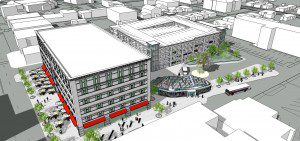 WESTFIELD – The state has approved the Elm Street Urban Renewal Plan which positions the city to seek the release of federal funds earmarked for the public-private development of a transportation facility, mixed use commercial building and a multi-deck parking garage.
WESTFIELD – The state has approved the Elm Street Urban Renewal Plan which positions the city to seek the release of federal funds earmarked for the public-private development of a transportation facility, mixed use commercial building and a multi-deck parking garage.
Aaron Gornstein, undersecretary of the state Department of Housing and Community Development (DHCD) notified Mayor Daniel M. Knapik that the state has approved the city’s Elm Street Urban Renewal Plan (ESURP), as submitted on June 28, with the intent “to revitalize Downtown Westfield by pursuing the development of an intermodal transportation center, retail, office and residential uses in a disinvested part of the downtown.”
Knapik said the DHCD approval of the Elm Street Urban Renewal plan “is an enormously important milestone in the effort to revitalize downtown.”
Knapik said the Sept. 26, 1986 fire that destroyed the Newberry store was another milestone, but a negative one marking the decline of the city’s core district.
“People expected that after the fire there would be an effort to rebuild, but there have been only two projects, the 1999 Elm Street Commons and the 2000 hotel-intermodal center,” Knapik said, adding that both of those projects were proposed without the leverage that an approved urban renewal plan provides.
“This urban renewal plan has been 27 years in the making,” Knapik said. “It’s amazing that 27 years have passed since the fire. It’s taken a lot of energy and effort to get to the point where we have approval for the plan.”
“I’d like to emphasis that Elm Street revitalization, that’s been talked about for three decades, is here now,” Knapik said. “The Elm Street Urban Renewal Plan gives us the tools to craft a positive economic impact.”
City Advancement Officer Jeff Daley, who also serves as the executive director of the Westfield Redevelopment Authority (WRA) said the DHCD approval positions the city to begin implementation of the urban renewal plan.
The plan authorizes the WRA to move into the predevelopment phase of the project, which includes submitting a National Environmental Policy Act (NEPA) report, which when approved makes federally earmarked funding available.
“The WRA has abilities that the city does not under the (MGL) Chapter 30 procurement laws,” Daley said. The authority is using a $230,000 state grant to implement the predevelopment phase of the urban renewal plan and to submit the NEPA report to federal authorities.
The NEPA report is about 80 percent complete and will be submitted in the next couple of weeks,” Daley said. “The NEPA review normally takes about 30 days. We could not do the NEPA report without state approval of the ESURP.”
“The urban renewal plan gives the WRA the ability to go after the federal funds earmarked for this project,” Daley said. “We still have a lot of work to do, but its beginning.”
The federal funds could be available to the WRA early this fall, allowing the WRA to pursue the next phase of the project, building acquisition and tenant, both residential and business, relocation.

